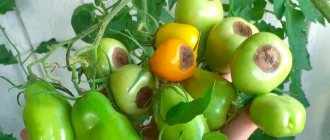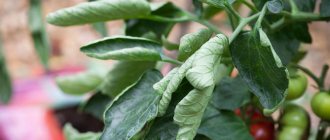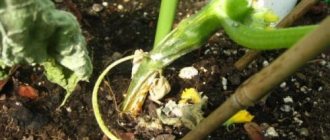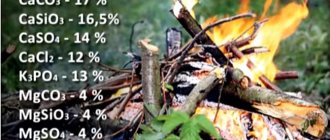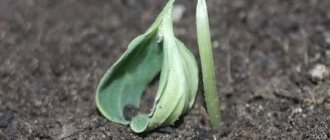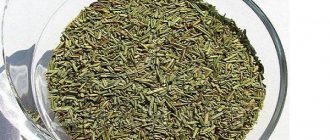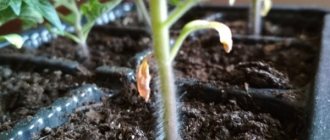Open ground problems
The leaves of tomatoes growing outside may turn black due to frost or disease.
In the first case, it is enough for the bushes to remain without shelter at temperatures below -3°C. This usually happens when it gets cold at night. The leaves droop, and in the morning under the sun's rays they turn completely black.
Most of the tomato diseases that accompany this symptom often affect plantings in open ground. Infection in a greenhouse is not impossible, but less likely.
To determine the pathogen, pay attention to the nature of blackening and other changes in the appearance of the bushes.
Leaves turn black and curl inwards
The tomatoes are probably affected by late blight. This is a common disease of nightshade crops, most dangerous in regions with a temperate climate, that is, the entire central zone of Russia falls into the risk zone.
The disease is caused by the late blight fungus. For its spores to germinate and penetrate plant tissue, a humidity level of at least 75% and a moderate temperature are required - already at +26°C the development of the population stops.
The most dangerous weather is when cool nights (+12...+15°) alternate with warm (+20...+24°), but cloudy days.
In protected soil conditions, the fungus rarely appears and, as a rule, only in film greenhouses.
The lower leaves are the first to suffer - they become covered with dark spots, the largest number of which are concentrated in the upper part or along the edges of the plate.
In damp summers, a light coating forms on the back of the leaves, outlining the boundaries of the spots. Later, the damaged tissues dry out.
The disease quickly spreads throughout the bush, reaching the top. Spots appear on both stems and stalks.
If the plant has already set fruit, brown areas will form near the stem, which will grow until they cover the entire tomato.
With sufficient humidity, these damaged areas are covered with a light coating of spores.
The plumping fruits retain a healthy appearance, while tomatoes suffer as they rapidly gain weight. Affected plants die quickly.
PHYTOPHORA ON TOMATOES - ENEMY No. 1. [An effective way to fight.]
Yellow-black spots on the leaves of mature tomato seedlings
The causative agent is the bacterium Xanthomonas vesicatoria, which is also dangerous for peppers.
The later the seedlings are planted, the higher the risk of infection with black bacterial spot.
- firstly, for development the pathogen requires a temperature within +25...+30°C;
- secondly, it is young plants that are least resistant to it.
Black spots in this case are specks up to 3 mm in diameter, surrounded by a narrow yellow border.
The dark areas have a watery texture; on young leaves they dry out and collapse, forming holes.
The spots appear between the veins, but as their number increases, the dark areas merge and can stain the vessels. Severely damaged leaves turn yellow and fall off. The seedling bushes have a depressed appearance.
Speckles also appear on stems and petioles, and depressed dark areas appear on green fruits that increase in size.
The tissue around the formation becomes watery, rots and cracks, and scabs appear.
The disease can affect tomatoes at any stage of development; it is least dangerous during the period of filling tomatoes, and most destructive for the bush at an early stage.
However, in the phase of active fruit growth, the disease can ruin most of the harvest, although the life of the plant is not threatened.
Round black spots on leaves
Concentric spots on the petioles and leaves may indicate tomato spotted wilt. This disease is usually accompanied by bronze spots on the leaves.
But besides the classical form of the flow, there is another one - necrotic bronzeness, in which black spots appear.
Not all of them will have a round shape, but the symptom is characteristic. It will be possible to more accurately determine the disease by the fruits - black-brown rings form on them.
The lesion penetrates deeply into the plant tissue, and the significantly damaged leaf dries out. Over time, the top of the bush dies off, but the tomato does not die. The yield is significantly reduced and the quality of the fruit suffers.
Differences in the course of the disease are due to the existence of several strains of the tomato spotted wilt virus that causes it.
The pathogen can infect eggplants, peppers and tobacco. If petunia grows next to a garden bed, necrotic spots on its leaves will accurately confirm the presence of the virus.
Symptoms usually develop after an attack by thrips, which serves as a vector for the pathogen.
Dark halo around a white spot
The infection is caused by the fungus Septoria lycopersici. The colony develops most intensively on tomatoes, but can also settle on potatoes and eggplants.
To develop, the fungus requires a temperature of +15 to +27°C and air humidity of at least 77%.
The disease often affects pears and moves from them to tomato beds, so it is better to place the planting away from the tree.
The spots are no more than 3 mm in size and can densely cover leaves, stems and fruits. The sign is characteristic of the second stage of septoria.
The first changes are difficult to notice; at first, watery spots that have no color appear. On young plants, which are more resistant to the disease, there are very few of them.
But very quickly the spots acquire a white color and a dark brown, and a little later - a dark brown halo. In the center of the white area you can see small black dots - these are pycnidia of the fungus.
Unaffected leaf tissues turn yellow and dry out. The leaves of the lower tier are the first to suffer; the top usually does not change its appearance.
The disease is most harmful for young tomatoes; in this case, yield losses can reach 40%.
The loss of a large proportion of the cover forces the plant to expend energy on growing new leaves with damage to the fruit. The bush produces small tomatoes with limp pulp.
Methods for solving the problem
When the first foci of infection of fungal etiology appear, it is necessary to urgently remove the affected plant from the garden. To completely destroy fungal spores from the beds, you need to perform the following steps:
- after harvesting, collect all remnants of vegetation from the soil, and it is necessary to dig up the beds using a spade;
- if the nightshade crop grows in greenhouse conditions, then after harvesting it is necessary to fumigate it using sulfur bombs. The smoke bomb must process the greenhouse structure within 24 hours;
- Before planting the crop, proper soil preparation is required, and then planting the seedlings;
- tomatoes grow better in places where there is good air circulation;
- It is better to water plants in the morning; tomatoes absorb moisture better at this time of day.
It is best to prevent fungal infections from occurring on tomato plantings. As a preventive measure, you should not plant tomatoes next to potatoes. Almost all varieties require pinching and bush formation. There should be at least 10 cm to the lower level of leaves on the main stem, since many diseases appear on the plant due to the proximity of the tops to the soil. Among the folk methods of combating fungal infections that cause tomato tops to turn black are the following methods:
- garlic infusion. To prepare the solution you will need 100 g of garlic, which is grated or chopped in a blender. A glass of water is added to the resulting slurry and left to infuse for 24 hours. After time, the composition is filtered and mixed with 1 g of potassium permanganate and ten liters of water. Spores die very quickly from garlic, the main thing is to use the product before the ovaries appear. After the first treatment, a second irrigation is performed 10 days later;
- milk serum. Wait until the milk sours and the resulting composition is diluted in equal parts with water. The solution is used to irrigate plantings. This product is suitable for both prevention and treatment of plants;
- ash. A week after planting the crop, fertilization with ash is carried out; plants can be irrigated using a solution of wood ash;
- saline solution There is a glass of salt per bucket of water. Then the plantings are sprayed.
The leaves turn black and dry in the greenhouse
Almost any tomato disease can appear in a greenhouse. Infection occurs through seeds or added soil; spores and bacteria are brought on clothes and tools by the gardener himself.
But there are also greenhouse diseases that rarely or very locally develop in open ground conditions. Some of them can also cause leaves to turn black.
The tissues around the edges of the leaves darken and dry out.
Round spots of dark brown color, concentrated along the edges of the leaf blade, are a sign of Alternaria blight. Another name for the disease is macrosporiosis. The disease is caused by the fungus Alternaria nightshade.
Alternaria blight affects plants at any age and develops most intensively in a greenhouse. All nightshades growing next to tomatoes are under threat.
Sometimes the damaged areas are surrounded by a yellow border. Gradually they grow, reaching a diameter of up to 1.5 cm, and in conditions of high humidity they become covered with a dense black coating.
The spots first appear on the lower leaves, but spread to all above-ground organs of the plant, excluding flower petals.
The spots on the fruit are black, round, dry, increasing in size and covering most of the surface. Affected leaves dry out.
Black areas on stems and fruits are cracking. As a result of the disease, the growth of bushes slows down, the quality of fruits deteriorates and their number decreases. The stem may break, leading to the death of the tomato.
Cladosporiosis (macrosporiosis) of tomatoes
Entire tomato branches turn black and dry out
This can happen due to end-to-end damage to the stems by gray rot. But first, brown, weeping spots of irregular shape appear on the leaves and stems; at high air humidity, a gray-white coating forms on them.
Later, the damaged areas dry out and become covered with a dark gray layer of fungal spores.
The disease is caused by the fungus Botrytis cinerea Fr. Conidia can penetrate the plant only through wounds, so symptoms often appear after pinching.
The bites of pests can also become an entry point for the fungus. Most often, plants in film greenhouses get sick, especially when planted densely, and less often in glass and polycarbonate greenhouses.
In open ground, gray rot rarely affects tomatoes.
The spots ring the stems, flowering tomatoes develop necrosis on the petals, and the flowers fade and fall off.
Brown wet spots covered with a velvety coating grow on the fruits. Plants die quickly, young ones are especially vulnerable.
Gray rot on tomatoes
Dark spots on the back of a tomato leaf
The sign appears at the sporulation stage of the fungus Cladosporium brown (Fulvia brown-yellow). At the beginning of the infection, the leaves become covered with yellow or light green round spots.
On the other side of the plate, the spot spots are covered with a light gray coating, which later acquires a brown or brownish-green color. Necrosis develops in damaged areas and leaves fall off.
For infection to develop, high air humidity is required - about 90%. The fungus is undemanding to temperature; it develops at +10…+32°С, but the best conditions for it are +22…+25°С.
Signs of cladosporiosis or brown spot begin to appear from the bottom of the bush; the disease rarely affects the upper tier, only in the case of intensive development of the infection.
Black depressed spots, covered with a black velvety coating, form on the fruits. The appearance of other parts of the plant most often remains unchanged.
The pathogen is dangerous only for tomatoes and usually affects in the greenhouse.
What can you do to prevent leaves from turning black?
If tomatoes grow in a southern climate with very high humidity, which cannot be avoided, the leaves may begin to shrink and turn black early on. Rot appears. Unfortunately, there is no way to control it; the affected bushes must be removed and destroyed.
It is possible to get rid of tomato fungi using chemicals: Quadris, Thanos, Madison, Skor, Ridomil Gold, Strobi.
There are also more gentle biological products: Mikosan, Baktofit, Fitosporin-M.
The most effective remedy is to prevent the development of the disease rather than to treat it. If your leaves are turning black, consider the planting conditions next year:
- Do not plant seedlings in the same place where diseased tomatoes grew. Change your landing site.
- Tie up the tomatoes, do not let them lie on the ground.
- Do not overfill with water to avoid too much moisture.
- Consider the temperature. If there may still be frost, cover the bushes at night.
- Make sure there is not too much sun, and do not allow it to dry out.
- Prevent diseases by spraying the lower leaves with special products. There is information that you can spray not only with chemicals and biological products, but also with products containing copper or iodine.
- Treat garden tools periodically.
Other reasons
Blackening of tomato leaves sometimes indicates a deficiency of certain elements. In all these cases, the symptom is secondary; other changes in the appearance of the bush appear earlier.
The leaves darken in different ways, the damage occurs either from the top or from the bottom of the bush, the edges may curl downwards.
The bushes turn black on top
Blackening of the growing point in tomatoes is a sign of severe boron deficiency. With a slight deficiency, the upper leaves on the bush curl and lighten, and the plant produces few flowers and ovaries.
In case of advanced boron starvation, large veins on the leaves become black or brown in color, and the plate becomes brittle.
The upper part of the stem darkens, below this area stepsons actively grow, and the bush branches heavily.
Eventually, the top turns black and dies, and over time the upper parts of the side shoots dry out.
During the flowering period, a lack of boron causes flowers and ovaries to fall off. At the fruiting stage, dark spots of necrosis appear on tomatoes.
The trace element is involved in the processes of photosynthesis, cell division and development, metabolism and delivery of sugars to fruits and growing parts of the bush.
Boron is necessary for the development of a strong root system and the growth of the above-ground part of the bush. The substance stimulates the formation of flowers and ovaries, the accumulation of sugars in fruits, increases resistance to fungal diseases and prevents fruit rotting in case of high humidity.
Microelement deficiency often develops in acidic or alkaline soils, sandy, calcareous soils saturated with organic matter and calcium carbonate.
Boron starvation can occur due to lack or excess of irrigation, overfeeding with nitrogen or potassium.
Lack of Boron in tomatoes!
Seedling leaves turn black
If the leaves of tomatoes acquire a dark purple color, and then begin to turn black and curl, it means that the plants do not have enough phosphorus.
The anthocyanin tint first appears on the leaves and stem at the bottom of the bush, gradually spreading upward.
But rarely does the plant turn completely purple; more often the top remains green. The tomato stops growing, bears fruit poorly and loses its immunity.
Phosphorus is necessary for flowering and fruit ripening; it ensures the development of a strong root system and, indirectly, affects the growth of green mass, since its deficiency interferes with the absorption of nitrogen.
Even if the soil is rich in this macronutrient, tomato roots cannot consume phosphorus due to too acidic or alkaline soils, or when the temperature drops below +15°C.
Element deficiency most often appears at the early stage of tomato development, but can also occur in adult plants.
Signs of phosphorus deficiency in tomatoes!
Tomato tops and leaves turn black
A brown spot forms at the top of the fruit, which becomes black, depressed and wrinkled as the tomato grows. The lesion may cover half of the fetus.
This is blossom end rot, a non-infectious disease caused by calcium deficiency.
Other manifestations of element deficiency are darkening of old leaves, chlorosis and curling of the edges downward in young leaves, growing necrotic spots from the edge of the leaf, and death of the top of the bush. Damaged tissue becomes an entry point for fungi.
Calcium is involved in the growth of roots and the green part of the bush, activates enzymes and stimulates metabolic processes.
Provides resistance to diseases and temperature changes, shelf life of fruits, and their taste and size also depend on it.
Deficiency is promoted by acidic and light peat soils, saline soils, and excess nutrition of magnesium or nitrogen.
Symptoms of blossom end rot due to element deficiency do not always develop; tomato varieties with elongated fruits are most prone to this.
The tomatoes are turning black on the bottom. TOP ROT - the result of my mistake!
Why do picked tomatoes turn black?
Anthracnose
It often happens that tomatoes, collected from the bushes and laid for ripening, suddenly begin to turn black and deteriorate.
The reasons for this phenomenon may be:
- lack of oxygen;
- increased or decreased storage temperature;
- high indoor humidity;
- infection of fruits with anthracnose.
Anthracnose is the main scourge of the already harvested crop. The fungus appears as small dots under the skin of the fruit that slowly turn black. The color of these dots initially differs slightly from the color of the fruit. But then the blackness becomes more obvious and spreads to the entire fruit.
The insidiousness of this disease lies in the fact that tomato bushes can be infected at the very beginning of the growing season, not appear in any way during the fruit formation phase, and immediately after harvesting the fruits suddenly begin to turn black. Most often, anthracnose affects tomatoes in open ground.
It is no longer possible to save the harvest in this option. Tomatoes, after harvesting, must be carefully examined, suspicious specimens must be rejected, and the remaining fruits must be quickly processed.
To prevent this disease, you need to do the following:
- during the growing season, carry out preventive treatments with Quadris or Strobi;
- Tomato tops, after harvesting, should be taken outside the site and burned;
- the soil on which the tomatoes grew must be disinfected with copper sulfate.
How to treat tomatoes against fungus
For the treatment of fungal diseases, treatment with drugs of the fungicide class is indicated.
Chemical agents are the most effective, but they cannot be used during the flowering period and later than 3-4 weeks before harvesting the fruits (the period varies for different drugs, it is indicated in the instructions).
It is unreasonable to completely abandon “chemistry” - any fungi are very difficult to remove, most pathogens overwinter safely and appear on plantings next year.
It is recommended to repeat treatment with fungicides after 10-15 days, even if there are no signs of disease. Some drugs require more treatments.
If the fight against the fungus has been going on for several years, it is advisable to use products with different active ingredients, since the pathogen quickly develops resistance to the poison.
If a lesion is detected during the flowering phase or shortly before harvest, when chemicals are contraindicated, spraying with biofungicides is resorted to.
Such products contain microorganisms that are safe for plants and feed on fungal spores and pathogenic bacteria.
Biofungicides contain no toxic substances and are safe for humans, animals and bees. However, you must prepare and use a solution with such a product strictly according to the instructions - bacteria die at the wrong temperature or in the light.
There are also folk recipes; they are more suitable for the prevention and protection of neighboring plantings that are not affected by the disease.
Such tinctures and decoctions do not penetrate the plant tissue, creating a protective film on the surface, so spraying must be repeated after rain.
Late blight
The disease can quickly spread throughout a tomato planting and spread to a bed of potatoes or eggplants, so when the first symptoms appear, it is important to localize the foci of infection.
Remove all leaves and branches affected by the fungus from the bush. The cuttings must be burned off-site.
You can’t put it in compost - the fungus will successfully overwinter and appear again next year. Disinfect the pruning tool with a dark solution of potassium permanganate.
After this, spray the bushes with fungicides. Choose drugs of combined action - contact and systemic, which not only destroy the pathogen on the surface of plants, but also penetrate deep into the tissues.
Drugs from the strobilurin group are indicated against late blight; active ingredients of this type contain:
- Pharmacist.
- Strobe.
- Profit Gold.
- Thanos.
- Famox.
- Healer, etc.
Among biofungicides, Fitosporin-M is the most effective. Alirin-B, Gamair, Trichoderma Veride 471 are also suitable.
Experienced gardeners recommend garlic tincture:
- chop 200 g of garlic cloves, best squeezed through a press;
- pour 250 ml of warm water;
- stand for 24 hours in a dark place;
- strain and dilute with a bucket of water;
- dissolve 1 g of potassium permanganate in the infusion.
The milk-iodine solution has proven itself well in the treatment of fungal diseases. It is better to take sour milk for it, ideally whey.
Solution recipe:
- dilute 1 liter of dairy product with a bucket of water;
- add 30 drops of iodine;
- mix and use immediately for spraying (do not store).
HOW I GOT RID OF PHYTOPHORA IN TOMATOES ONCE AND FOR ALL!
Septoria
First, remove all affected plant parts. Dark spots on the leaves in the case of septoria appear already at a late stage of the disease, so folk remedies are useless, it is necessary to use “chemistry”.
Fundazol, Ridomil Gold, Acrobat MC, Thanos, Revus are suitable for this.
Use the last two products for treatments in rainy and cold summers; unlike others, they work in any weather.
Of the biological drugs against septoria, Sporobacterin works well.
For prevention and support, additionally spray the bushes with a weak solution of potassium permanganate (1 g of potassium permanganate per 10 liters of water).
Alternaria blight
The same chemicals that are indicated for late blight, with active ingredients of the strobilurin group, are suitable for the treatment of macrosporiosis.
In addition to them, drugs based on triazoles are effective, for example, Raek, Racurs, Skor, as well as copper-containing products.
The last group includes copper sulfate, Bordeaux mixture, and Burgundy liquid.
These drugs can also be used in the treatment of late blight and septoria, but Alternaria and Cladosporiosis are considered clear indications for their use. The treatment is carried out after the formation of ovaries; it is not used before flowering.
In rainy summers in open ground, spraying should be repeated every 10-12 days, the last treatment no later than 8 days before harvest.
Fruits from treated bushes should be thoroughly washed before eating.
The easiest way is to prepare a solution of copper sulfate, but for tomatoes, Bordeaux and Burgundy liquids, products with lower acidity, are more suitable.
In Bordeaux mixture, alkalization occurs due to lime, which also ensures the “tenacity” of the solution, extending the protection period to up to a month.
The vitriol solution is valid for 2 weeks. But lime blocks the leaves’ access to oxygen, so Burgundy liquid, in which soda acts as an alkali, is a more gentle remedy.
Rules for preparing a solution of copper sulfate:
- Mix the product in plastic or glass containers; iron buckets should not be used. This applies to all copper-containing products.
- To prepare 5 buckets of solution, dilute 100 g of copper sulfate in 1 liter of warm water (40-50 degrees). When the crystals dissolve, dilute the concentrate with the required volume of water.
- To treat tomato bushes, the solution concentration should be 0.2%. That is, 1 bucket will require 20 g of the substance.
- If a sprayer is used for spraying, the product is filtered to prevent any remaining crystals from clogging the nozzle.
In Bordeaux mixture, the concentration of copper sulfate should be 1%.
For 1 bucket of product:
- Pour 100 g of the substance into 0.5 liters of warm water in a plastic or glass container. Stir.
- After the crystals have dissolved, add water, increasing the volume of the solution to 5 liters.
- In another container (not metal), dilute 200 g of lime with cold water.
- Mix the lime solution well and add water to make 5 liters of liquid. Mix thoroughly again.
- Pour the vitriol solution in a thin stream into the lime solution. You can only mix this way; you cannot pour lime into vitriol.
If you place a new iron nail in Bordeaux mixture and it does not become covered with rust in 2-4 minutes, then you can safely spray tomato bushes with the product. This method is used to test acidity.
To prepare 5 liters of 1% Burgundy liquid:
- Dissolve 50 g of copper sulfate in 100 ml of warm water.
- Separately, dilute 25 g of soda with water.
- Drain both liquids into one bucket.
- Add water to make 5 liters of product.
- Dissolve 25 g of laundry soap shavings in it to increase the “stickiness” of the liquid.
Use any of these three solutions immediately after preparation.
Alirin-B, Gamair, Fitosporin-M are suitable as biofungicides against Alternaria.
In advanced cases, without regret, remove the most affected bushes from the garden bed and burn it away from it to stop the spread of infection.
Cladosporiosis
Before processing, remove diseased leaves. When a leaf is torn off, light conidia will disperse into the air, infecting other plants, so wrap each leaf in a plastic bag and carefully cut with a knife.
For cladosporiosis, bushes are also sprayed with copper-containing agents, and if they do not help, “heavy artillery” is used - chemical fungicides. Suitable for Polyram, Polychom, HOM, Bravo, Tsineb. The most effective biological products in this case are Pseudobacterin-2 and Fitosporin-M.
In addition, try to reduce the humidity in the greenhouse to at least 65%, and keep the temperature within +25...+30°C. Under such conditions, the fungal colony will develop more slowly.
Stop watering for a while and weed the planting - the pathogen can develop on weeds. Burn the weeds along with the cut leaves.
Treatment with iodine solution will be useful:
- Dissolve 40 drops of iodine in 10 liters of water and mix.
- Spray the bushes and spill the soil under the tomatoes.
- The soil should be wet to a depth of 10 cm.
Ash solution is also used:
- Boil 300 g of ash in 3 liters of water for half an hour.
- Dilute the solution in 7 liters of water and leave for 3 days.
- Spray and water the bushes with the prepared product once a week.
Add a little laundry soap to the ash or iodine solution for spraying (not for watering!) so that it sticks better to the leaves and stems.
Gray rot
To treat gray rot, cut off the affected areas of plants with a sharp knife and burn them outside the greenhouse away from the beds. The procedure should be carried out in dry and sunny weather.
After pruning, treat the plantings with chemicals Bayleton, Previkur, Skor, Topsin M, Acrobat MC, Agat 25K, Maxim, Euparena multi, Oxychom, Ordan, Fundazol.
In case of minor damage, spraying with Bordeaux mixture or Profit, Kuproskat, Roval, Champion, Ditan M-45 will be sufficient. For biological protection, use Gamair.
Coat the spots on the stems with a paste of any preparation suitable for spraying. To do this, dissolve 20-50 g of the substance in a bucket of water (the volume should correspond to the dosage of the product per 10 liters of water). Add crushed chalk in portions until the mixture becomes a paste.
Spray healthy tomatoes with Trichodermin or Fitosporin-M. Apply the same solutions to all plant wounds that form during pinching; the fungus penetrates only through damaged tissue.
Three folk recipes against gray rot:
- dissolve 100 g of baking soda in 10 liters of water;
- Grind 100 g of laundry soap into shavings and dissolve in a bucket of water;
- prepare a 1% solution of boric acid (10 g of substance per 1 l).
Any of these products should be sprayed on all bushes, including healthy plants.
Fighting methods
When tomatoes turn black, you should pick off the affected fruits, leaves and stems. It is better to bury them or burn them. Do not throw into the compost heap. It is useful to cut out some of the healthy leaves. In this way, improvement of ventilation and illumination of plants is achieved.
Chemicals
Chemicals can be used to combat the problem. The number of treatments depends on weather conditions. In rainy weather, it is worth treating the plants especially carefully. The quantity can reach 5 times. Spraying should be carried out in dry, windless weather. Fertilizing will be effective to strengthen weakened bushes.
In the fight against diseases, such agents as “Fitosporin”, “Trichopol”, calcium chloride, and copper sulfate solution are used. It is necessary to treat all parts of the plant: stems, leaves below and above, stalk. This way you can prevent rot from getting into the middle of the fruit.
Calcium nitrate
To prevent tomatoes from turning black due to blossom end rot, they must be treated with calcium nitrate. It is used on any soil, especially effective on acidic soils. The fertilizer is used as foliar feeding, dosing 1.5-2.5 g per 1 liter of water. To spray plants, 10 square meters. m. 25 g of the drug is diluted in 10-15 liters of water. The treatment is carried out twice: the first time during mass flowering, the second time when the fruits are the size of a walnut.
Folk remedies
Folk remedies are also used in plant treatment. Prepare a milk-iodine solution: for 10 liters of water, add 1 liter of milk and 15-20 drops of iodine. Spraying is carried out every 2 weeks. You can use whey, which is diluted with water in equal parts. Processed every day starting in July.
How to treat other tomato diseases
Unlike fungi, viruses are resistant to all existing drugs.
It is recommended to dig up and burn affected specimens to stop the spread of the disease.
In the case of tomato spotted wilt, the bush can be left, especially if it is only slightly damaged, since this virus does not spread through the air and only enters through wounds.
But when pests, especially thrips, appear, the risks of infecting other plants become high.
In other cases, there is still a chance to restore the health of tomatoes with blackened leaves.
Black bacterial spot
At the initial stage of the lesion, biological products such as Fitolavin, Planzir, Fitosporin-M, Baktofit, Gamair are quite effective. If the disease is actively spreading through the bushes, copper-containing products are used.
You can spray with Bordeaux mixture, but in this case a solution of copper oxychloride is preferable.
To prepare it, dilute 40 g of the substance in 10 liters of water. This volume is enough to spray 1 hectare of planting. Repeat after 14 days. A total of 3-5 treatments are allowed per season, the last of which must be carried out no later than 20 days before harvesting the fruits.
Like other products in this group, copper oxychloride cannot be used during flowering.
Copper-based chemicals (Alpha-Copper, Kuproskat) or mancozeb (Ditan M-45, Pencozeb) are also suitable for combating black spot.
Frost
When the temperature drops to -3°C, irreversible processes begin in the body of tomatoes. But sometimes it is possible to revive them in this case too.
A strong remedy that often helps even when the roots freeze is a solution of cow manure or bird droppings.
Dilute cow manure with water in a ratio of 1 to 10, the concentration of the solution with bird droppings should be 2 times less - 1 to 20.
Use only rotted manure or old droppings, otherwise you can burn the roots of the tomatoes. Water the prepared solution 1 liter per bush.
If there is no cow manure, water the tomatoes with humates. Dissolve a tablespoon of Gumat-80, Gumat Universal or similar preparations in a bucket of water. Before this fertilizing, water the plants generously.
Trim the top of the bush to healthy tissue only in case of minor damage, after which the tomatoes are fed with urea or ammonium nitrate.
These are nitrogen fertilizers that will help restore foliage cover. In both cases, 20 g of the substance is required per bucket of water.
For heavily damaged bushes, pruning will become unbearably stressful. If the plants survive, the blackened top will gradually dry out on its own.
Regardless of the degree of damage, spray the bushes with immune stimulants (Epin-extra or Stimul). For the next week after hypothermia, keep them under a film cover.
If frost is detected at night, there is a chance to minimize the consequences. Spray the tomatoes with water and shade them from the rising sun. The slower the bushes thaw, the less they will suffer.
Element deficiency
If there is a deficiency of any substance, feed by foliar feeding. Tomatoes absorb nutrition faster through their leaves than through their roots.
If the plants do not have enough phosphorus, dissolve 15 g of superphosphate in a liter of boiling water and leave to infuse for half a day.
Add 300 ml of the prepared infusion to each bucket of water for spraying and mix.
In case of boron starvation, treat the bushes with a solution of boric acid. In this case, the dose is increased to 1 g of product per 1 liter of water. For routine feeding, make a 0.05% solution.
Dilute the powder with hot water (at least 55°C), otherwise some of the crystals will not dissolve, which can result in leaf burns.
Before spraying, wait until the solution cools to room temperature. You can dilute the powder with a small volume of hot water, and then pour the concentrate into cold water, this will save time.
Replenish calcium deficiency with calcium nitrate. The recommended dosage is 20 g of the substance per 10 liters of water.
Repeat spraying once a week until you are sure that blossom end rot has stopped affecting new fruits.
Tomatoes with spots cannot be revived; pick them from the bush and burn them - fungus may already live in them.
To prevent fungal diseases, it makes sense to treat the bushes with an ash solution (as against cladosporiosis), adding 15 g of soda per bucket.
Cladosporiosis
Brown spot or cladosporiosis most often affects tomatoes grown in winter greenhouses. The source of the disease is neighboring plantings, last year's plant debris, contaminated soil or seeds.
Symptoms of cladosporiosis:
- The plant wilts with sufficient watering.
- Yellow streaks or spots appear on the upper side of the leaves.
- The bottom of the tomato leaf is covered with a brown coating.
- Affected leaves darken and curl over time.
- The ovary or unripe tomatoes lose their juiciness and dry out.
What to do first when cladosporiosis is detected:
- Weed the tomatoes and clear the beds of vegetation.
- Cut and then burn diseased shoots.
- Treat the bushes with fungicides or preparations based on copper compounds.
Alternaria blight
Dry rot, as Alternaria blight is otherwise called, is a fungal infection common to all nightshades. The disease manifests itself at any stage of the growing season and affects not only the leaves of tomatoes, but also the stems or fruits. The bush begins to turn black, dry out and may die completely.
- The above-ground part of the plant is covered with small dark concentric spots.
- The affected areas enlarge, turn black and dry out.
- The surface of the lesion is covered with a coating of spores.
- The disease causes necrosis of inflorescence tissue, starting from the stalk.
- The spots on the leaves turn black, and a yellow halo appears along the edges.
- Black areas on the stems dry out and crack.
- Dark circles cause cracks in ripening tomatoes.
- spraying with fungicides or biological products;
- normalization of watering;
- ventilation of the greenhouse.
The main reasons for blackening of tomato tops
Among the main reasons why tomato leaves turn black are the following negative factors:
- Late blight. The causative agent of the disease is a fungus that rapidly attacks tomato plantings. The first signs include blackening of the tops of the crop. After black spots appear on the leaves, a white coating becomes noticeable - mycelium;
- Apex rot. Most often observed in young seedlings, after planting in a permanent place of growth. First, black spots appear, then dry leaves and curled tops become apparent;
- Brown spot. A disease caused by a fungal infection. At the initial stage of disease development, a phenomenon is observed when tomato leaves turn black. Then the tops are curled and dried. If the disease is not detected in a timely manner, the plant will completely die;
- Gray rot. A very dangerous disease for tomato crops. Leads to damage to both stems and leaves and fruits. The disease develops in cool and humid weather. At the initial stage, small black spots become noticeable, then the infection occupies a large area and the leaves of a tomato in a greenhouse or open ground turn black. It is very difficult to save infected plants and, in most cases, treatment is aimed at preventing damage to other cultivated plants on the site.
Along with dangerous diseases, blackening of tops can be observed as a result of insufficient aeration of plantings. Tomatoes need constant fresh air. Potatoes also do not have a beneficial effect on tomato crops. As a rule, fungal diseases appear first on the tops of root crops, then on vegetable plantings. If you do not take timely measures to treat the plantings, you will not be able to save the crop.
Prevention measures
Hygiene is of great importance in preventing tomato diseases. And if harmful microflora has already manifested itself in the area, it will not be possible to get rid of it without thorough disinfection.
- Disinfect seeding material and soil for seedlings.
- Handle tools. For example, dip a knife or scissors for pinching into a solution of potassium permanganate every time you move on to the next plant.
- Do not forget to remove weeds, they often become the first hosts of pathogens and pests.
- After harvesting, remove tops, fruit residues, and weeds from the beds and burn them.
- In the fall, dig the soil deeply.
- Fumigate the greenhouse with sulfur, burning 40-50 g per 1 m3.
- Treat all parts of the greenhouse with formaldehyde (200 cm3 of 40% substance per 10 liters of water). Pay special attention to the wooden frame - this is a favorite place for fungi to overwinter.
- Carry out scheduled treatments against pests. Many of them carry diseases.
- Follow crop rotation rules whenever possible. It is best to place tomatoes in an area where no nightshade crops have grown in the previous three years.
To prevent fungal and bacterial diseases, spray your plantings with biological products. In this sense, Fitosporin-M is the most universal remedy.
Traditional recipes will also come in handy; treat the bushes with solutions containing garlic, ash, and whey. It is useful to dust bushes with dry ash to prevent rot.
And, of course, plants that are provided with proper care always show higher resistance to diseases.
Most often, diseases are provoked by:
- excess watering;
- sprinkling irrigation;
- high air humidity in the greenhouse, lack of ventilation;
- excessive planting density.
You should inspect the tomato bushes every day, paying attention to any changes in their condition.
The earlier diseases, pests or nutritional deficiencies can be detected, the greater the chance of coping with the consequences without damaging the crop.
CAUTION Are tomato leaves turning black? Diseases of tomatoes in open ground
Tomato varieties resistant to blossom end rot
Even among modern varieties and hybrids, it is difficult to find tomatoes that are 100% resistant to blackening of the tips. Poor agricultural technology can provoke disease even with high immunity. But several representatives of tomatoes can be recommended as the most unpretentious to growing conditions:
It is possible to avoid blackening of the tips of tomatoes if you take a number of preventive measures and strictly follow the rules of agricultural technology. But if infection occurs, the diseased fruits are removed without regret, and the bushes with the remaining healthy vegetables are disinfected. You should not ripen such tomatoes and collect seeds from them - blossom end rot is transmitted genetically.
Why do the lower leaves of tomato seedlings turn yellow?
Lack of light... In cloudy weather, even with backlighting, there is not enough light for them. Due to low light, tomatoes stretch out and their lower leaves begin to turn yellow. With severe light deficiency, the entire plant acquires a yellowish tint, and the lower leaves become bright yellow.
Interesting materials:
How to properly dilute sodium hypochlorite? How to properly breed goldfish? How to correctly register orders for main activities? What is the correct decision or solution? How to plant hyacinth correctly? How to plant a chrysanthemum correctly? How to plant carrots correctly? How to properly plant an orchid in an indoor pot? How to plant peppers correctly? How to plant watermelons and melons correctly?
How to fight
To prevent late blight, it is recommended to spray the bushes with warm, slightly salty water. If there is a suspicion of the initial stage of the disease, then it is useful to carry out the procedure of spraying with a 1% solution of Bordeaux mixture. However, Bordeaux solution is effective only in the initial stage, and for healthy tomatoes it is better to use a salty solution.
When keeping tomatoes in a greenhouse during the initial ripening phase, it is important to water the fruits regularly - once every 2 days, and in hot weather, watering should be done daily. When fertilizing tomatoes, it is also necessary to moisten the soil so as not to burn the roots and ensure better absorption of substances.
You should not get carried away with nitrogen fertilizers, as frequent fertilizing can cause the development of blossom end rot. It is also not recommended to allow intensive growth of tops during the period of fruit set. As a preventive control measure, seed treatment in a weak solution of potassium permanganate is considered effective.
Another reason for the darkening of tomatoes is increased acidity of the soil, which can be corrected by adding lime, wood ash or ground chalk before planting.
Treat your tomatoes with care and monitor for any changes in their condition in order to detect the disease in time and eliminate it. Infected fruits should be disposed of immediately, as they are still unfit for consumption.
To prevent gray rot, spraying plants with garlic infusion is useful - leave 30 g of chopped garlic (arrows can be used) for 2 days in 10 liters of water.
Brown rot (fomoz) - develops near the stalk. It may be a small spot on the outside, but the core of the tomato will be completely rotten. To protect your crop from this disease, you should also avoid fertilizing with fresh manure.
The soil
When planning to plant plants in a greenhouse, take care of the soil. A fungal infection affects tomatoes at the stage of fruit formation, the diseased bush withers, and the reddening tomatoes are spoiled by brown spots. Infected plant residues should not get into the soil, otherwise the future harvest will be ruined.
Biological drugs
Alirin-B.
Gamair.
Trichoderma veride.
Fitosporin-M.
The following biological fungicides are allowed to be used on private farms:
- " Alirin-B, Zh ." During the growing season, three treatments can be carried out. The drug does not have a waiting period before harvesting the fruits.
- " Gamair ". Active ingredient: Bacillus subtilis strain M-22 VIZR. Treatments should be carried out every 5–6 days. The drug has no waiting period. Available in the form of a wettable powder or tablets. The working solution is prepared by dissolving tablets in water (2 pieces per 10 l). The consumption rate is 10 l per hundred square meters of plantings.
- " Trichoderma veride ". The active ingredient is Trichoderma veride strain 471. The microscopic fungus suppresses the action of a whole complex of pathogens, releasing a natural antibiotic during its vital activity, and disinfects the soil of the greenhouse. The working solution is prepared by adding the drug (30 g) to a bucket of water. The prepared volume is enough to process hundreds of tomato plants.
- " Fitosporin-M, F. " The spore culture of bacteria is the basis of the drug. By releasing vital metabolic products, it suppresses the action of the main pathogens of tomato diseases, including late blight. Prepare a working dilution by dissolving 5 g of dry substance in 10 liters of water. This amount is enough to treat one hundred square meters of area.
